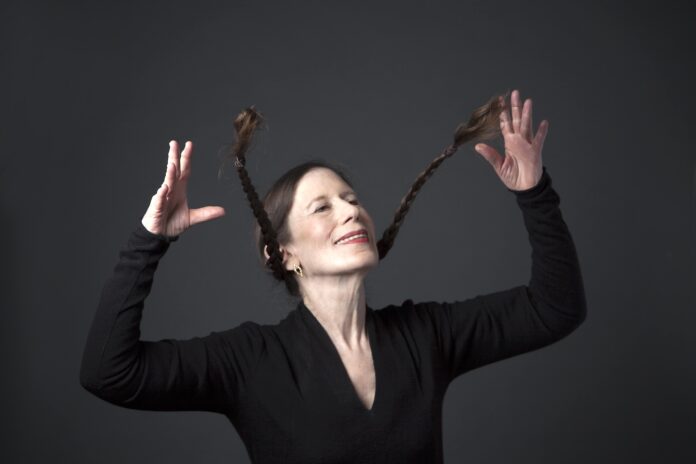In a recent rare interview with Meredith Monk, the renowned multi-genre artist always pushing into the future, the phrase “and then” repeats like like a sequence of ivory-white beads in a gemstone necklace.
Those simple two words string together Monk’s luminous, generative thoughts and imaginings—about the next project, new music and movements, future and past rehearsals, and experiences aligned with being 81, yet inhabiting a body and soul that seemingly transcends aging.
A singer, composer, choreographer, dancer, and filmmaker, she speaks about the cultural leaps and historical echoes in the work she has made for six decades. There are expectations of the coming generations of performing artists, and then there are lush landscapes of ideas ripe for exploration, and then there are continuing opportunities to learn something new with longtime fellow performers she adores—and who will be the guardians of her vast catalogue of work when she is no longer with us.
Monk’s expansive curiosity and unbounded approach to topics sometimes leads conversations on delightful, off-shooting trajectories. But her focused mind—much like her work—never meanders without purpose, nor are her presentations esoteric or cliché. Her tone and laughter retain a quality of simple, childlike wonder that mirrors her repertoire, much of which is composed of pure utterances that outstrip language.
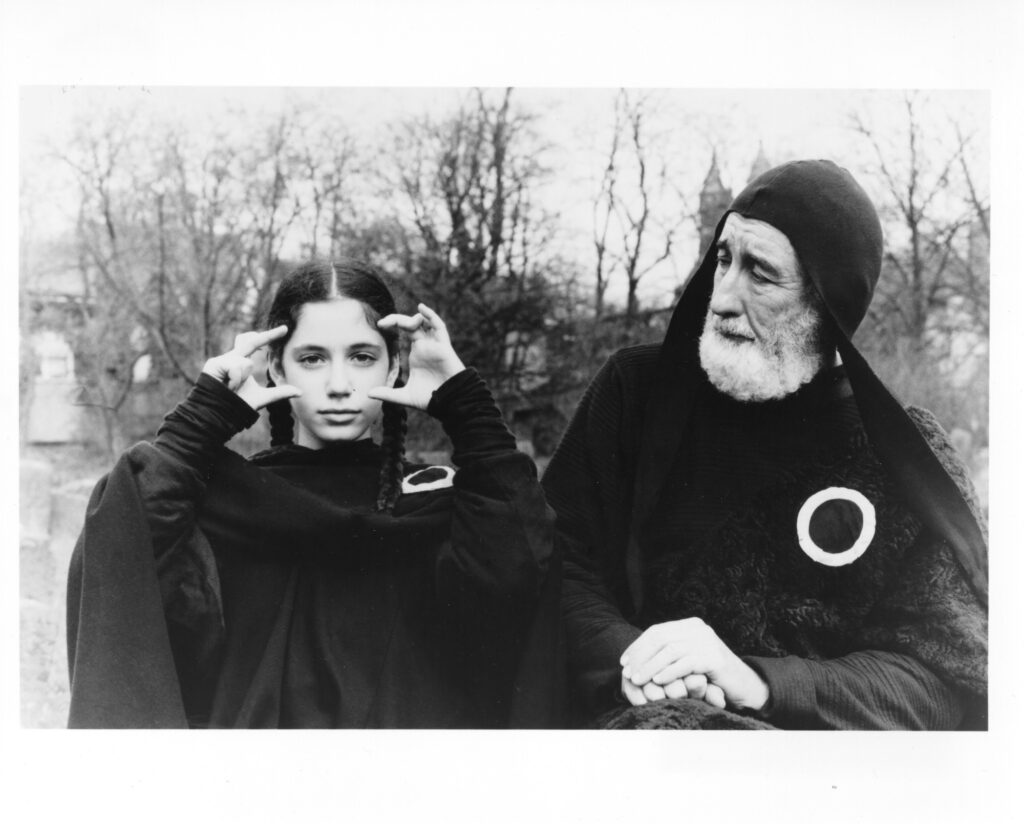
In works from 1966’s 16 Millimeter Earrings and 1988’s Book of Days through On Behalf of Nature (which stunned at YBCA in 2015) and 2018’s Cellular Songs, Monk has used her ethereal vocal compositions, along with accompanying movement and visuals, to evoke transformative environments: sensuous whispers, guttural wails, wild grunts and growls, deep inhalations and exhalations, wonderful and often funny alien sounds. Monk thinks about music visually, viscerally, from the cavernous cosmos to microscopic doodle. Current work-in-progress Indra’s Net is no different, and our conversation encompasses that evolving piece, as well as this year’s marvelous European retrospective exhibit of her work and the final stages of completing an accompanying, long-awaited book.
The exhibit, Meredith Monk. Calling, opened at locations in Germany and the Netherlands and is a collaboration with the Oude Kerk, Amsterdam and the Hartwig Art Foundation. The book, edited by Anna Schneider, includes an interview with Monk, accompanying essays, and never-before-published archival material, musical notations, drawings, and photographs. The latter is a project she is eager to complete.
“This book has taken three years,” Monk says. “The irony is, you examine your life, but you might die doing it. It was supposed to be finished in late 2023 and come with the exhibit in Amsterdam. We’re finally coming to the end and I’m panting, but it will be beautiful to look at.
“I loved the exhibit in Holland. I was in tears when I walked in the door,” she said. “Basically, they were three-quarters of the way done and still, I could see what it was going to be. It was such a strange feeling, I was like, ‘Oh my god. Who is this person, (me), who did all this work?’ When I look at the book, it’s the same. It kind of makes you into a thing.
“But my feeling about my life was that I was just devoted to something, to always moving, learning. Some things were more successful than others but it was always process; making things, being with people, sculpting my music or movement. The joy and curiosity has always kept me going. It doesn’t have the same feeling when I’m looking at the book. I’m thinking, there’s a lot here, maybe too much?”
The exhibit, when presented in a 700-year-old church in Amsterdam, integrated its complex audio-visual structure into the venue’s grand interior, which accommodated three huge LED screens. Among the pieces shown were components that make up Indra’s Net. “Rotation was on one screen and Hand Mandala was on another one, and Reflection was on the third screen. Each of these pieces have in-sync sound that played consecutively. It was a rotation: You hear Rotation, which is 10 minutes long. There’s an orchestra and we’re singing and it’s lush. And then, walking around to look at the other two videos, you’re still hearing the track of Rotation. For me, it displaced the choreography and made the images shift.
“And then, the next moment, you’d hear the soundtrack of the Mandala film and might see the Rotation video. The sound in that church was magnificent. It was fluid, public. There were also spaces and alcoves like little rooms that had been sound-proofed. You walked down a corridor to get into the rooms and you could be intimate with the music in a meditative space. I felt I could bring my sleeping bag and stay overnight. It was an intense, private experience.”
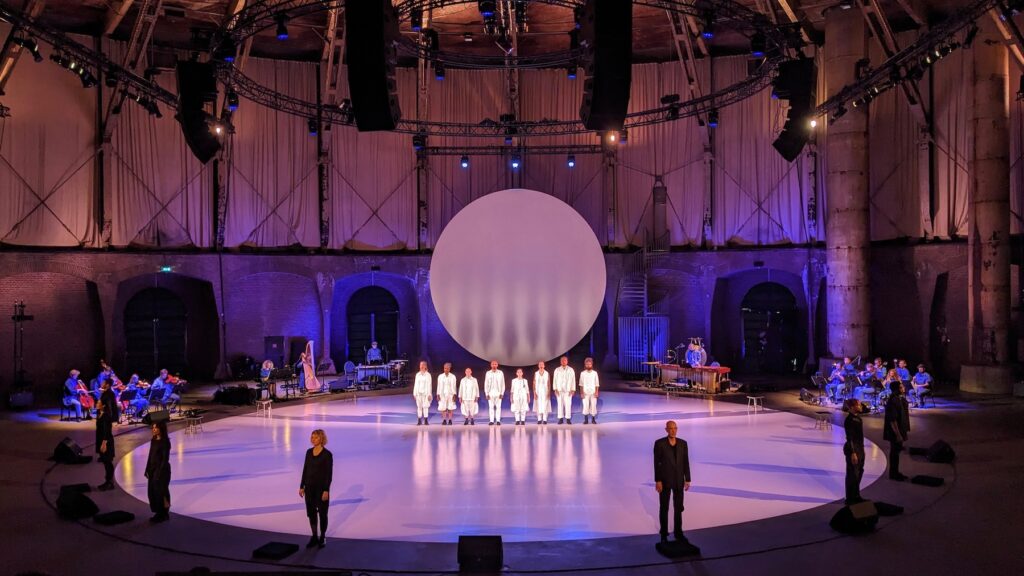
Monk says she met people who traveled long distances and spent five hours in the space, and then, drawn back to the immersive, integrated world, returned to spend five more hours the next day, and then the next.
Some of those travelers might have encountered Monk’s work in 2021 at Oakland’s Mills College (now known as Mills College at Northeastern University in Oakland). The concert version of Indra’s Net was launched there in an experience Monk says was “entirely wonderful,” and a thrilling place “to give birth to the ancient Buddhist-Hindu legend about the interdependence of all things.”
Since that time, she and her company have continued to develop the work’s full production elements. “There is more movement, more films, more visual aspects. I had always thought of the piece in a large open space. At Mills, it was going to be a little small, but that was OK, since it was during the pandemic and we couldn’t have the performers too close to the audience. And then, after that, we were going to be doing it at a beautiful space called the Westergasfabriek (now known as Westergas, the former gas factory in Amsterdam’s West district that used for cultural and recreational purposes). It’s a huge, round performing space where they used to store gas. The setting was Incredibly inspiring and seeing the piece come to full-form life was extraordinary.”
In each place Indra’s Net is performed, the orchestra includes young local musicians. Monk engages young people fresh out of schools and conservatories, or professionals early in their careers. “They’re used to being in a pit, playing with a score. In this piece, they have to memorize some of the material and they’re right on stage with us. At the end, they actually move with us. The young players are radiant on stage. There, right there, is the metaphor of interdependence and fluidity between the orchestra, the performers and the chorus. The end of the piece is a weave of these three elements.”
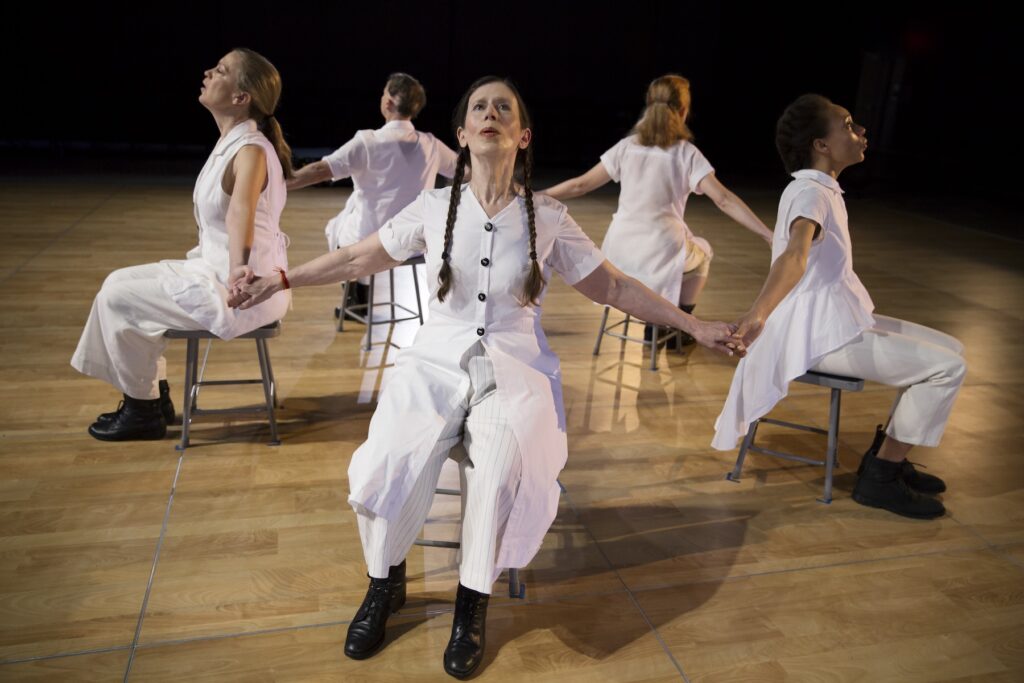
Monk says people get into trouble when they think about themselves and others as solid, fixed, separated individuals. “This gets into Buddhism and philosophy, but part of our problem is that we think we’re solid. That we’re separated from everything else. And from that basic ignorance comes fear and war and everything we’re seeing in the world right now. The more fluid we can be—to know we are many people in each of us, that we are not this unchanging thing—the more we stay completely open to the energy that is flowing to us from other people ,and then to nature and back to us… that’s reality. That fact is terrifying to most people. They build an (isolated) identity and treat other people that way. That’s where conflict starts.”
Monk tends to think scientifically and mentions that human cells and biology are in a constant state of change. She also thinks sensorily, kinesthetically, and historically, wondering about the next generation and the onslaught of the digital realm.
“I’m curious about levels of reality and modes of perception. Levels of reality are realms of existence. What I mean by modes are hearing, seeing, smelling, touching, tasting. These are modal means, whereas levels of reality are different, with different ways of thinking about them. In my work, I would say in Indra’s Net, there’s the celestial realm that’s spacious, delicate, ephemeral. Then there is also the earthy realm of us, and there’s even the below ground, the microscopic realm.
“You can label them until kingdom come, but I wanted to make a work that’s multi-dimensional where people can hook in wherever each person does. Modes of perception allow that. Not every sense organ is included in the piece, like the sense of taste, but you can use recipes as metaphors as in Recent Ruins, a piece I did in 1979.”
In Recent Ruins, a musical section called “Dolmen Music” constitutes the overture. “And then the next section was about archaeology and becomes more image-based and theatrical. Isolating elements in sections to emphasize them is another way of working. In any piece, you can weave or isolate, but you are always aware of the different elements. Then, you decide whether to use each one, or not.”
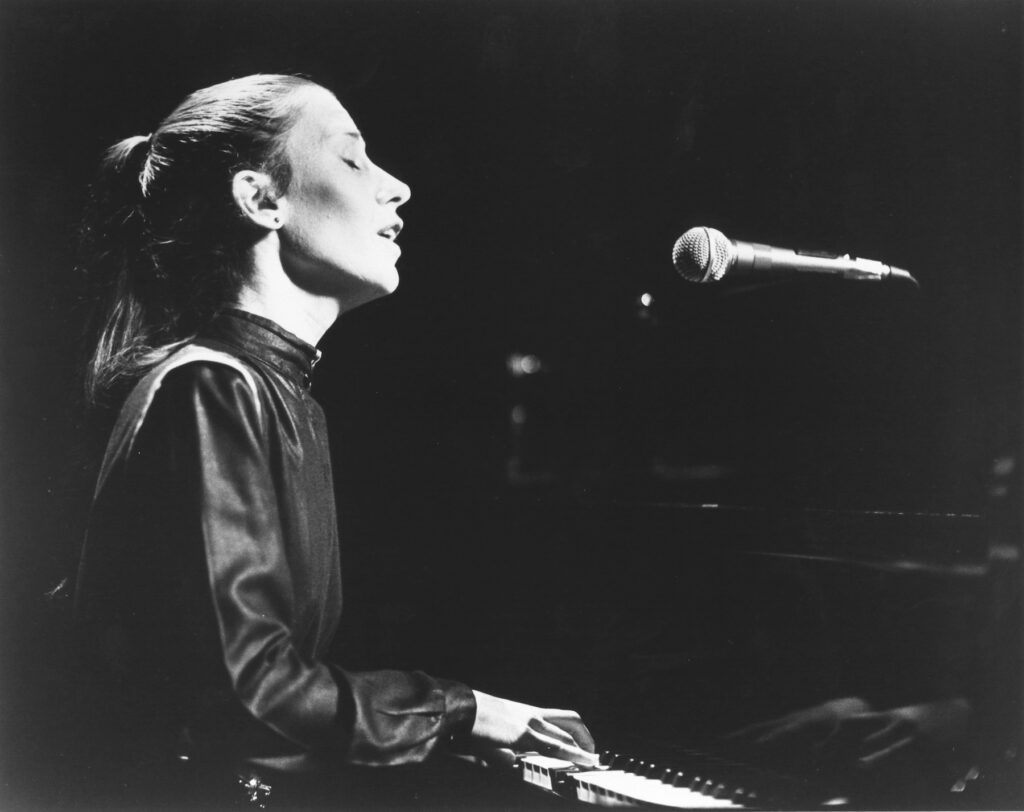
Monk recalls that the music world in “the old days,” when she first came to New York, required forgetting about visual aspects. “There was no attention paid to it. I’m thinking of mostly the classical music world. That didn’t make sense to me. Even in a concert form, you want to have something beautiful to look at. When there is, you actually hear the music better.”
Because her work is what she calls, “largely un-score-able,” Monk spends time thinking about how best to pass it along to the next generation. “I trust the people in my ensemble. Our internal, visceral scenario, even if we intend to pass it along, no one has to know what it is. I want performers to have their own stories. I don’t have to know a musician’s internal particulars, but (they) have to know them, because it makes your playing more specific, with more tone.
“Even if you are the maker, you may not know consciously what that is. And how do you pass that subconscious world on? The people I am working with it know that world and they know it deeply. When we give live concerts, we say we are living the music. How do you pass that along to the next generation?”
She finds it sad that it seems some young people are less interested in music, film, and dance history. “The reference points mean there’s not a lot of interest in that. But it’s exciting to know that there are other young people who are indeed interested and will carry on the cultural richness. It’s not that we’re old people thinking our time was better. When we were young and coming up, the culture—there was a spirit of inquiry. I think now, the devices overwhelm everything. There’s so much information coming in, you don’t have time to be curious. With no references to the past and everything filled in so fast, I worry about the imagination.”
This is an affliction Monk is unlikely to ever suffer. “I already have a new piece I’m working on that I can’t articulate yet, but it’s there. It’s enough that I can say I’m moving along.”
She says essential-izing is frequently the driving force in her newer works. “The more you subtract, the more you give room for other people to have their imagination. The faster the culture is going, the slower my work is,” she laughs, adding, ”I want time and space for people to experience the works in unique ways. I don’t think of the audience as a mass, but individuals. I offer an experience people can take in however they take it in.”
The evanescence of experience has become a key theme in Monk’s later work, and its conceptualization is contributing to how she currently views her own life’s work.
“Basically, all we have in our lives is experience. And I’m more and more convinced that all we leave behind is our love. I worked with that idea when I did Impermanence [2006]. You have a loved one who dies and the idiosyncratic personality traits, likes and dislikes, and other qualities you think are that person, they kind of leave. But what stays behind is that person’s love. Wherever you’ve funneled your love, that is what you’ll leave behind when you leave the earth.
“I feel fortunate I’ve been able to live this long, because I get a different perspective on it. I still give everything I’ve got to everything I do but there’s different perspective on the moments and what’s important. Love: that’s all we have. The Beatles knew about it and articulated it.”
When a plan to speak again soon is made, Monk laughs, and in a voice exactly replicating this interviewer’s, she says, “Yup, that’s the pla-yun.” And then, she might add, who knows what’s next?


